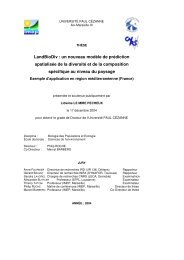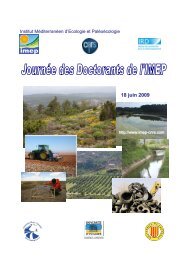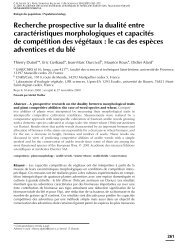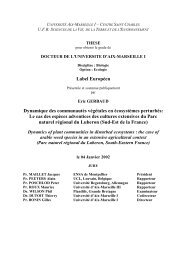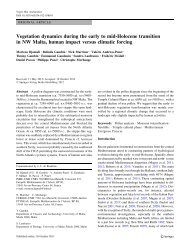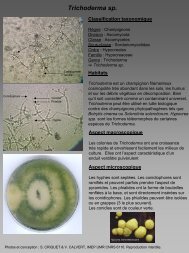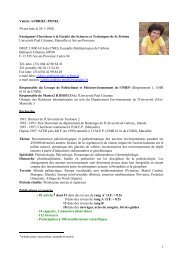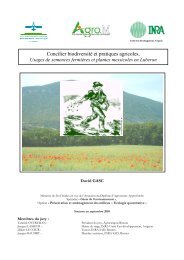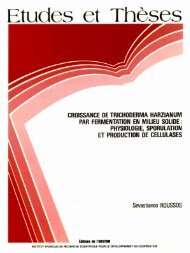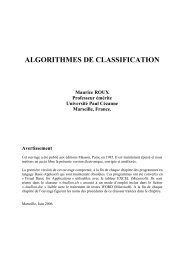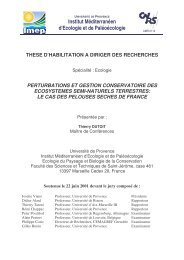UNIVERSITÉ PAUL CÉZANNE, AIX MARSEILLE III - IMEP
UNIVERSITÉ PAUL CÉZANNE, AIX MARSEILLE III - IMEP
UNIVERSITÉ PAUL CÉZANNE, AIX MARSEILLE III - IMEP
Create successful ePaper yourself
Turn your PDF publications into a flip-book with our unique Google optimized e-Paper software.
Résultats et discussion. Chapitre 1 : Criblage des souches de L. edodes<br />
shown that the metabolism for decolorization requires the presence of readily available carbon<br />
source, such as glucose (D’Annibale et al., 1998). Enzymatic determination using ABTS<br />
(2,2'-azino-bis-(3-ethylbenzothiazoline-6-sulphonic acid) test (Collins et al., 1998), showed<br />
that most selected strains, except Le118, were capable of producing laccase on PDA without<br />
OMW (data not shown).<br />
Comparative assessment, based on apical growth rate and biomass yield on OMW<br />
agar medium, showed that the strains Le118, Le119, Le121 and Le122 were the most<br />
efficient, and accordingly selected for further evaluation of decolorization and the removal of<br />
total phenol from OMW. The inhibitory effects of OMW on fungi have already been reported<br />
(Fountoulakis et al., 2002; Alaoui et al., 2008). Considering this fact, dilutions of OMW were<br />
prepared to allow mycelial growth of L. edodes. In this study, the use of mycelium previously<br />
grown on PDA containing 2% of OMW resulted in enhanced tolerance of strains to inhibitory<br />
compounds from liquid OMW. This positive effect of pre-adaptation to OMW, previously<br />
reported for several white-rot fungi (Leontievsky et al., 2002; D’Annibale et al., 2004), has<br />
been attributed to the triggering effect of phenolic compounds for inducing the production of<br />
ligninolytic enzymes (Fenice et al., 2003 ; Farnet et al., 2004).<br />
Laccase was detected as the main lignin-degrading enzyme in strains studied, which<br />
was similar to previous reports (D’Annibale et al., 2004; Olivieri et al., 2006). It has also been<br />
reported that LiP and MnP are capable of decolorizing and removing phenolics from OMW<br />
(Sayadi and Ellouz 1993, 1995). The molecular weight of phenolic compound from OMW<br />
was modified by all strains at different levels. The strains Le119 and Le121 were able to<br />
reduce all fractions obtained from OMW extract. This was in agreement with previous results<br />
from Jouani et al. (2003) and D’Annibale et al. (2004). However, Casa et al. (2003) reported<br />
the appearance of a novel phenolic fraction in OMW after treatment with laccase.<br />
The difference of distribution patterns from aromatic compounds was also observed in<br />
OMW incubated with the fungus P. chrysosporium in liquid culture, which was associated to<br />
the production of LiP, and with purified LiP (Sayadi and Ellouz, 1993, 1995). This<br />
interpretation is based on the assumption that other auxiliary degradative mechanisms<br />
involving enzymes and small molecular weight agents, such as hydrogen peroxide and oxalic<br />
acid (D’Annibale et al., 1998), are implicated in the breakdown of aromatic substances, which<br />
could serve as substrates brought about by white-rot fungi (Durán and Esposito, 2000). The<br />
68



